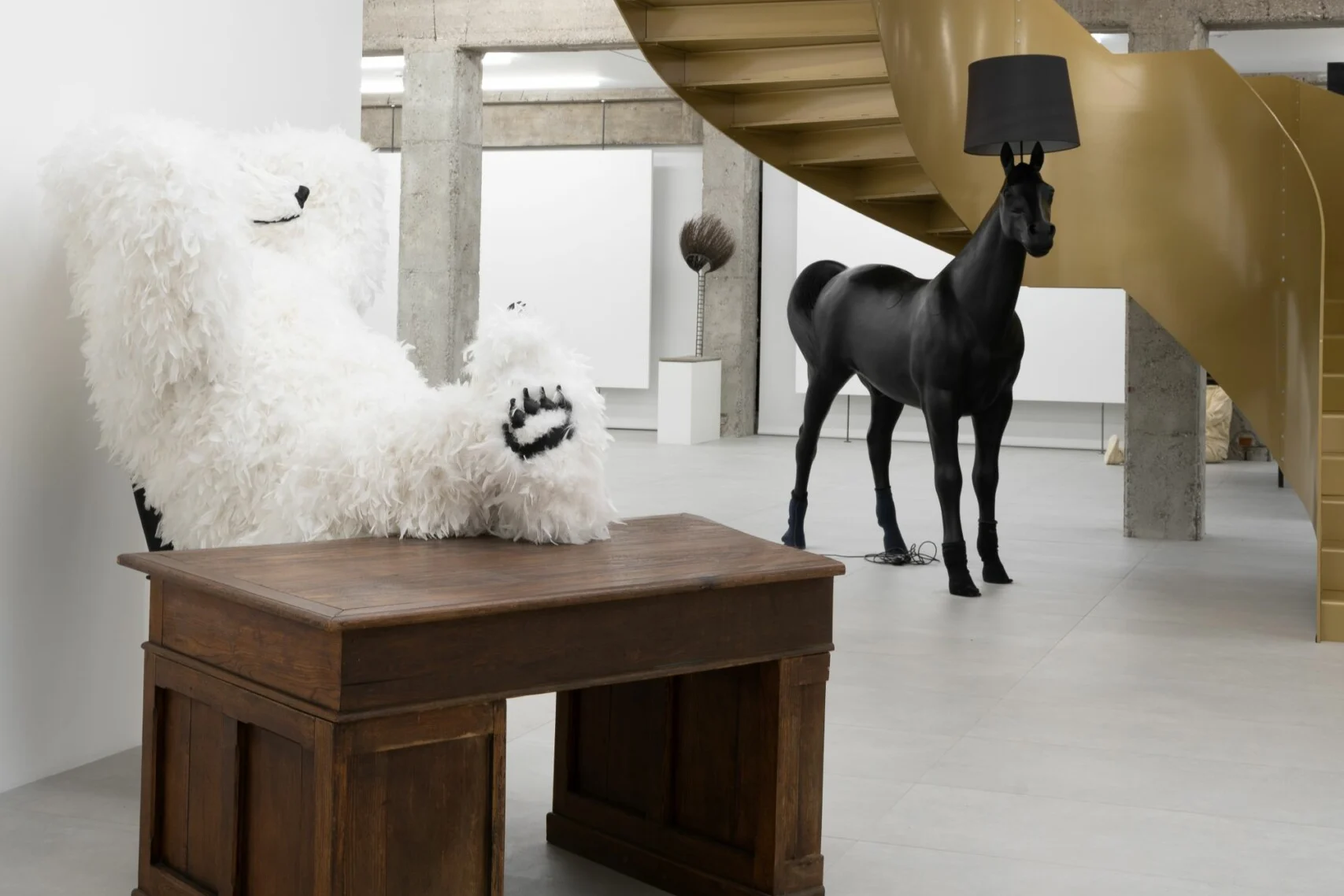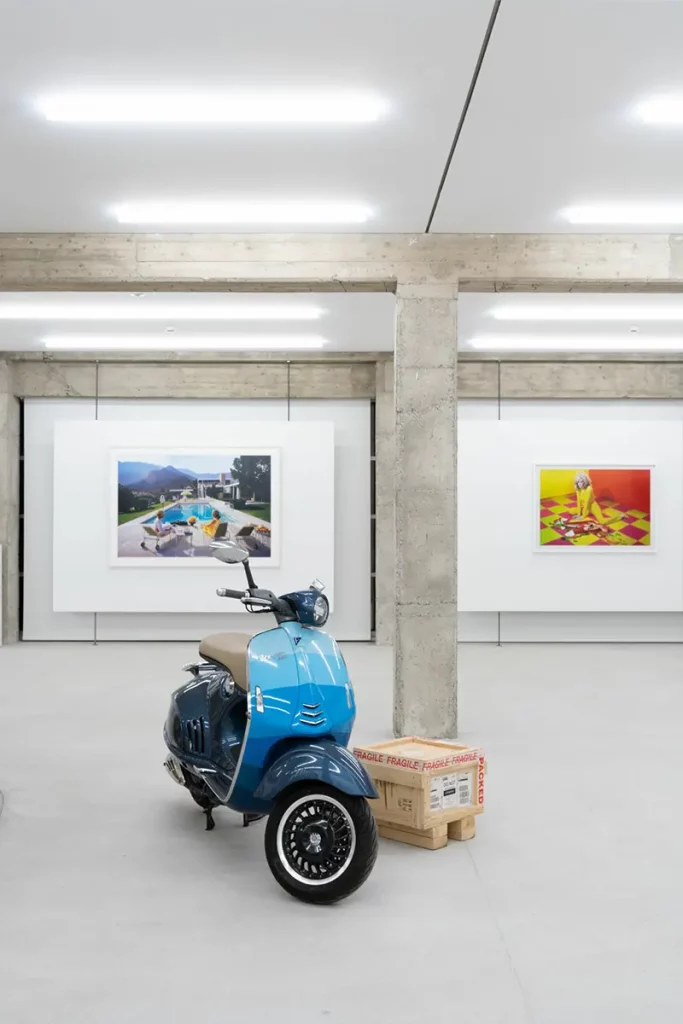«Spazio Almag is a space where we talk about artists, where people can browse a bookshop, a space where they can lock themselves in the video room and watch video art or NFTs»
The origins of the relationship with art: Umberta Gnutti Beretta
Federico Jonathan Cusin: When did art become not just a passion but a universe to be experienced, collected and in which to invest?
Umberta Gnutti Beretta: «Art was part of my childhood. My grandfather painted for fun, my father took me to exhibitions and I liked to draw. I wanted to go to art school but in the end I opted for something else. When I turned eighteen, I asked for a work of art as a present for my birthday. A large painting of a glacier by Velasco Vitali. I saw it in a magazine and wanted to have it. That first gift was the beginning of my true passion. Also around that time, I started visiting museums, meeting artists, browsing around in auction houses. Today, art occupies much of my time and most of my thoughts».
Umberta Gnutti Beretta on collecting a work of art
Federico Jonathan Cusin: When choosing an artwork, do you proceed by intuition or do you follow a more formal line of thought linked to art-historical and economic factors?
Umberta Gnutti Beretta: «Everything I have chosen over time has been the result of a combination of elements. I am not a true collector because there is no rule or thread connecting my purchases. Rather, mine is a collection of works that has followed my process of learning and getting to know the art world. As I learn and discover, I happen to desire something that fixes that moment. Many of the works I own are by artists I have known or even with whom there is a friendly relationship; others are works I decided to buy because I had been following the artist’s work for some time by going to fairs, exhibitions or talking to gallerists. I rarely make economic evaluations and even if art sometimes proves to be a good investment, for me it is above all an emotional investment».
Spazio Almag
FJC: How did the idea of Spazio Almag and the need to share a private collection with the public come about?
UGB: «Spazio Almag had long been a wish of my father, who was also a collector of antique works. He had been telling me for some time that he would have liked to put some work in and make the space visitable. Lately he was convinced it would be interesting to show my collection rather than his own. I found the idea laborious because the space had to be created and the works to be moved were quite numerous. When we started to think about Brescia and Bergamo as Culture Capitals with the local administration inviting private individuals to contribute with their own initiatives, we decided to realize the project. In six months we adapted one thousand and three hundred square meters of disused office space. It was quite a ride, but we did it».
A space for contemporary art in the outskirts of Brescia: Studio Almag
FJC: The town of Roncadelle was chosen for Spazio Almag. How necessary do you think it is for the art system to invest in less well-known and ‘peripheral’ realities compared to Italian and international art centers?
UGB: «I am happy with the choice. I think it is an added value for everyone who has to come there, customers, suppliers, etc. Roncadelle is close to Brescia and easy to reach from Milan. Those who are interested can certainly travel a few kilometers. I don’t know if something like Spazio Almag will change the face of Roncadelle. I don’t think so. It could certainly encourage other people to do something within their companies».
Bergamo and Brescia Italian Culture Capitals for 2023
UGB: «Everything we are doing, we are doing above all for this occasion. It wants to be a service to the city. A place to add to the map of things to see. Brescia’s programme is already rich, but contemporary art has the advantage of being interesting and the possibility of being organized and managed in a non-formal way. The collection grows and every now and then spits out a new work. The events I organize together with Edoardo are always different and aimed at different people. We will do as much as we can between now and the end of the year».
The range of artworks in Spazio Almag
UGB: «There are about one hundred and forty works in Spazio Almag. They are works that were mostly in my house and that I started collecting thirty-seven years ago. In the beginning, my economy allowed me to buy little. As I grew up, I was able to afford a bit more».
Edoardo Monti, curator of the collection
FJC: As the curator of the collection, what criteria did you follow in organizing and displaying the artworks in Spazio Almag?
Edoardo Monti: «I let myself be guided mainly by the space, to allow each work to breathe and to enter into dialogue with the surrounding pieces. Presenting large sculptural works, as well as paintings, photographs and drawings, I started with the first ones and continued with the smaller works. The space, being housed within an industrial complex, in fact presents various volumes and different opportunities to set up. It is nice to be able to think of a temporary order, which can dynamically change with new acquisitions and additions».
FJC: Do you identify a characterizing feature of the entire collection?
EM: «It is a collection that celebrates relationships before objects, the relationship with the other before work. Only two artists were already dead at the time of acquisition: Lucio Fontana and Andy Warhol. All the others, with the exception of Lucian Freud who was nevertheless still alive at the time of the acquisition of his four works, are alive and with them Umberta has woven strong personal relationships over the years. Sometimes you can find small thematic niches: the wall with young female painters, the section of photographs of Marilyn Monroe, but generally there is a constant flow between masters and emerging artists, a homogenous whole that places everyone on the same level».
Emerging artists in Umberta Gnutti Beretta’s collection
FJC: In addition to historicised names or those already applauded by critics, what relationship do you have with young artists? Are there any under-30 Italians in your collection?
UGB: «In recent years I have looked a lot at the work of young artists. In the space we have created, established and emerging artists coexist. Two of the youngest are Giovanni Stefano Rossi from Brescia and Theloniuos Stokes, an American artist based in Florence».
FJC: Also in the light of your experience at Palazzo Monti, what attention does Spazio Almag pay to young artists and how is it committed, in particular, to promoting new Italian talent?
EM: «Many artists who have passed through Palazzo Monti, a residence I founded in 2017 in Brescia, are present in the collection, demonstrating Umberta’s interest in even art that I define as ultra-contemporary. These are works by artists who are still fresh when they are acquired and installed, often by artists who do not yet belong to the traditional contemporary art market, but with whom we establish beautiful human relationships and you end up identifying in one of their works a beautiful memory, an interesting conversation».
The interdisciplinary nature of Spazio Almag
FJC: Art, fashion, philanthropy: can Spazio Almag be an interdisciplinary place where, in addition to the collection, you can promote the themes you are most attached to?
UGB: «Spazio Almag is a space where we talk about artists, a space where people can browse a ‘special’ bookshop with limited editions and unique pieces, a space where they can lock themselves in the video room and watch video art or NFTs. We also hosted talks in the space. The first was given by Andrea incontri, Benetton’s creative director but also an all-round creative with his project Le Tipe Umane. In a month’s time, we will host ‘lectures’ on contemporary art. We have also promoted opportunities for conviviality and dialogue by organizing two lunches and two dinners. It is a space in the making».
FJC: From a curatorial point of view, does Spazio Almag envisage collaborations with cultural institutions and universities in order to deepen the research that can originate from the works in the collection?
EM: «We are open to dialogue, with public and private institutions, as well as with schools and sector groups. We have already dedicated a day to FAI members and are organizing other visits for universities and academies interested in visiting. We do not exclude, in the near future, some structured collaboration, which will also see part of the collection tour Italy and the world».
Umberta Gnutti Beretta
Brescia, 1968. She studied in Lausanne, Geneva, Rome, London and Lugano and worked in the family business dealing with the purchase of raw materials. She works actively in charities with non-profit associations and foundations, with a focus on fundraising. Always passionate about contemporary art, she founded Spazio Almag where her collection can be visited.
Edoardo Monti
Edoardo Monti (1991) after studying at Central Saint Martins College in London and spending five years at Stella McCartney’s in New York, decided to focus on contemporary art, transforming the historic family home into an artists’ residence in the center of Brescia, Palazzo Monti.




















